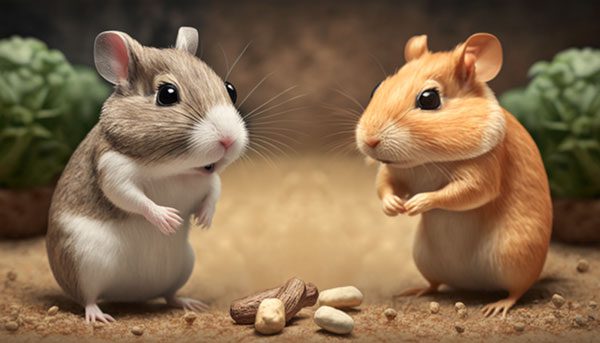Gerbil vs Hamster: What Are The Differences
Gerbils and hamsters are both cute, and hairy little popular pets. They are the species most typically preserved as pets. And both of them share many similarities though there are some differences in their habitats and nature.
So, Gerbil vs Hamster: what are the differences? Gerbils are sociable and are best kept in pairs, whereas Hamsters are solitary animals and are best kept alone. Likewise, Gerbils have long and soft tails and Hamsters have small and stubby tails.
In this article, we’ll be discussing the differences between Gerbil and Hamster. You can read further to get more fascinating information about these popular household pets.
The Differences Between Gerbils And Hamsters
The table below shows the differences between Gerbils and hamsters in brief.
| Gerbils | Hamsters |
|---|---|
| Move in groups | Prefers to move alone |
| 4–5 inches in length | 6–7 inches in length |
| A diurnal animal | Generally a nocturnal animal |
| Generally a social animal | Prefers an isolated life |
| Long and soft tails covered in fur | Short or stubby tails |
| Higher risk of overheating and hence requires proper ventilation | Little or no risk of overheating |
| Enjoy standing on their hind legs | Hardly stand on their hind legs |
Gerbil vs Hamster: What Are The Differences
Here are some of the main differences between Gerbil and Hamster.

1. Size
On average, Gerbils are bigger than most species of Hamster but they are smaller compared to Syrian Hamster. Gerbils typically grow to be around 4-5 inches (10-13 cm).
And Hamsters usually grow to be around 6-7 inches (12-15 cm). However, the exact height of a Gerbil or Hamster can vary depending on their breed and individual genetics.
2. Social Behavioral Difference
Gerbils are very active, friendly, and playful. They enjoy staying in the company of other Gerbils. Hamsters, on the other hand, are more solitary and prefer to stay isolated.
Also, Gerbils have a more complex social structure with dominant orders. And an incredible ability to interact with each other through body language and vocalizations.

On the other hand, Hamsters are typically more territorial and may come to be hostile toward other Hamsters if they are lodged together.
3. Cage Size
Gerbils are more active and need a larger room to move around and play. But Hamsters do not need quite a larger room because of their solitary nature.
4. Difference In Maintenance
Since Gerbils release very small urine and their feces are tiny and hard, you will need to tidy up the pool every 14 days and improve as required.

Hamsters, on the other hand, require at least three feet of steady bed area. And with the perfect-sized room, the cage can be spot checked and an entire tidy-out can occur for 4-5 weeks at a time.
5. Difference In Lifespan
Generally, Gerbils have a longer lifespan than Hamsters. The majority of Gerbils can survive for about 3-5 years, while most Hamsters can survive for about 2 to 3 years.

6. Difference In Diet
Gerbils and Hamsters are both omnivorous pets. However, Gerbil’s diet consists of more assorted food that contains fresh veggies, fruits, and seeds.
However, Hamsters are more adaptable in their feeding patterns, they eat insects, green leaves and berries. They also feed on fruits and plants and can manage periodic delicacies cooked and uncooked rice and root vegetables) and commercial pellets diet.
Further, both pets will require sufficient protein. Hamsters typically need about 19%-23% of protein (for example, eggs and fish) daily. Whereas Gerbils will need about 13%-15% of protein every day. Both can also have grasshoppers and worms as meals.
7. Difference In Temperament
Hamsters are most effective at night and so are called nocturnal animals. They prefer a solitary lifestyle and don’t even enjoy sharing their room with others. Hence, they’re usually kept alone as pets.
Gerbils, on the other hand, are most effective during the day and are called diurnal animals. They enjoy living and moving around in groups. And they possess an inquisitive and cheerful temperament.

Furthermore, Hamsters are said to fight to the end when other animals intrude into their territory. Yet, they’re usually very docile regardless of being territorial with other Hamsters. While Hamsters can be naturally nice towards humans, they can also bite occasionally, especially when afraid, sick, or looking for food to eat.
Gerbils are naturally nice towards humans and are less likely to bite or attack even when handled. They are also generally manageable and more docile.
However, Hamsters can come to be tame but will not condone being seized for a lengthy period. This is why they are not very suitable pets for kids. Gerbils, on the other hand, are incredibly nice beginner pets.
8. Difference In Face Shape
Gerbils have tall noses and slim faces that appear more like a rat’s face. Also, they do not have the cheek cavities that Hamsters are popularly known to have for storing food. Although Gerbils don’t have cheek cavities, they are still recognized to take meals back to their habitat.
Hamsters, on the other hand, have a round face with small, rough noses and unique cheek cavities for reserving and carrying food from one place to another. And these cavities can extend to their shoulders.
You can watch this video t see the differences between hamsters and gerbils.
Similarities Between Hamster and Gerbil
Hamsters and gerbils have some similarities, including

Size: Both hamsters and gerbils are small, furry rodents that are often kept as pets.
Diet: Both hamsters and gerbils are omnivorous, meaning that they eat both plants and animals.
Habitat: Both hamsters and gerbils are burrowing animals, and in the wild, they would create tunnels and burrows to live in. As pets, they both require a cage or enclosure that allows them to burrow and dig.
Helpful Tips On How To Handle Gerbils And Hamsters

- When you want to handle a gerbil or hamster, approach them slowly and gently to avoid startling them.
- Give them a chance to sniff your hand and get to know you before you try to pick them up.
- To pick up a gerbil or hamster, place one hand under their body and the other hand over their back.
- Avoid grabbing them by the tail to prevent wounds. Be sure to support their weight and avoid squeezing or dropping them.
- Hamsters are liable to bite during handling. You can wear hand gloves.
- Both pets should have frequent veterinary attention.
- Supply them with regular and current rolls of wooden toys.
- Provide getaway-proof cages with stable covers for them.
- Ensure the temperature condition is around 64°-76° and humidity is around 45%-50%.
FAQs
Here are some frequently asked questions about Gerbils and Hamsters:
Q; Which Is More Friendly: A Hamster Or Gerbil?
A Gerbil is more friendly than a Hamster. Gerbils are suitable pets for kids who are unskilled in taking care of little animals.
The reason is that they’re energetic all through the day and hardly attack or even bite. Hamsters will attack when held or scared.
Q: Do Hamsters or Gerbils bite?
Hamsters tend to bite strangers. But gerbils hardly bite, whether they know you or not.
Q: How Closely Connected Are Gerbils and Hamsters?
Both are rodents. Although, they come from diverse family species. Hamsters evolve from the Cricetidae family while Gerbils evolve from the Muridae family.
Conclusion
Gerbils and Hamsters can make great pets. While gerbils and hamsters share some similarities as small rodent pets, there are several key differences between the two. These differences include their social behavior, activity level, dietary needs, lifespan, and handling. All these can impact their suitability as pets for different individuals and lifestyles.
Ultimately, the choice between a gerbil and a hamster as a pet will depend on personal preferences and considerations. This includes the level of interaction and care required, as well as the available space and resources for their housing and care.




